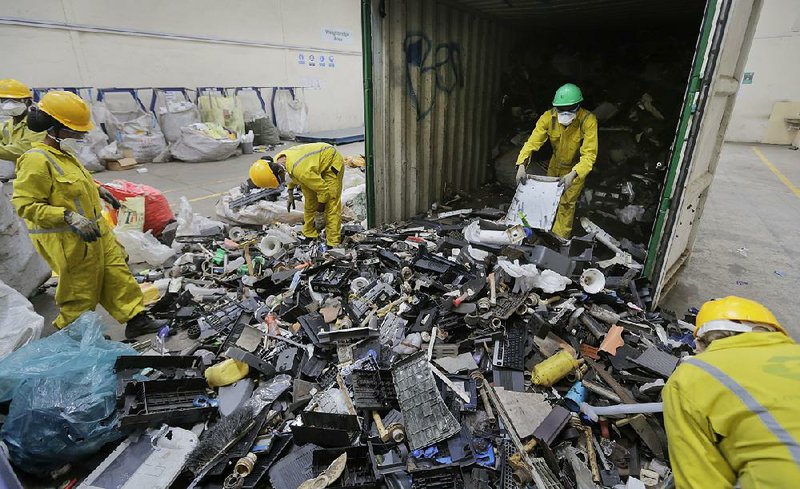The image is taken almost as gospel: tons of old computers and phones, their sometimes toxic innards spilling out, piled up in Africa or Asia, a symbol of the developed world's cavalier use of poorer nations as a dumping ground for garbage and, by extension, other ills.
The reality is that image is just as obsolete and in need of an upgrade as the old gadgets being dismantled, according to a just-released two-year study of Europe's electronic waste. But even as the developed world breathes a little easier, an electronic waste crisis is looming in developing nations where smartphones, laptops and other digital products are becoming affordable to billions of new customers, yet the means to dismantle them safely are largely nonexistent.
As a result, the often dangerous and environmentally destructive methods of disposal, if they're not addressed soon, will have consequences for the developing world far beyond what may have been caused by whatever Europe exported in the last few years. Electronic waste is the world's fastest-growing waste stream, and getting it to places that have technology--and markets--to handle it is crucial.
The new study, financed by the European Union and conducted by Interpol, the United Nations University and several other partners, found that only 4.2 percent of the 9.5 million metric tons of e-waste generated in Europe last year was exported to developing countries as actual waste. (An additional 9.4 percent was exported as used working goods.)
None of this should be surprising. The results echo recent studies of e-waste from the United States. For example, a 2013 study led by the Massachusetts Institute of Technology posited that the U.S. exported as little as 3.1 percent of its e-waste by weight, while the U.S. International Trade Commission surveyed 5,200 electronic recycling businesses and found that less than 4 percent of U.S. e-waste went abroad for disposal or--more ominously--"unknown" reasons.
Though each of these studies has flaws, they find support in data from Africa in particular. A 2011 study found that only 9 percent of the electronics imported into Ghana--widely reported to be one of the world's premier e-waste dumpsites--were nonfunctioning electronics that needed disposal. Meanwhile, a 2012 study from the UN Environmental Program showed that 85 percent of the waste electronics generated in West Africa came from domestic consumption.
And that domestic consumption is growing across the developing world. A June 2015 report from Swedish telecommunications goliath Ericsson said that three-quarters of global mobile phone subscription growth came from Africa and Asia, a trend it expects to continue through 2020. China already has more than 1 billion mobile phone subscribers, and India (with 970 million) and Africa (with 910 million) will soon have that many, too.
Some of those phones are bought new, and some are imported used from other countries (for example, among the 700,000 tons in the Interpol report). But all eventually will become obsolete and need recycling and disposal.
Everyone's rapidly becoming equal when it comes to electronic waste. In 2013, electronic waste generated by the developing world exceeded that generated by the developed world, according to a United Nations University study. The numbers are jarring. In 2014, for instance, China generated 6 million metric tons of electronic waste; by contrast, far more developed Japan generated 2.2 million metric tons. And it's not just big countries. Over the last three years, for example, Bangladesh has imported 63 million new and used mobile phones yet lacks laws, much less technology, to deal with them at the end of their usable lives.
The solution most often proposed to solve the e-waste dumping issue--a ban on exports from developed countries--obviously won't fix the problem in Bangladesh or anywhere else, and would most likely have the unintended consequence of keeping low-cost used devices out of the hands of people who can't afford new ones.
Likewise, even though Europe is exporting far less than conventional wisdom might hold and its electronic waste laws and systems are widely acknowledged to be some of the strictest in the world, Interpol's report acknowledged that nearly half of Europe's e-waste is being "mismanaged" on the Continent, from landfills to suboptimal recycling.
Theoretically, a business opportunity exists here. One ton of personal computer scrap contains, on average, more gold than what's contained in 17 tons of average-grade ore. But building the infrastructure to collect, much less extract, that resource is a multibillion-dollar undertaking that few developing countries can handle. China has diligently built up the world's largest e-waste collection system, but isn't close to making it financially self-supporting. In addition, record-low commodities prices make such investments highly unattractive, to say the least.
Far better, then, over the long term is for manufacturers and product designers to create products that can be easily repaired and upgraded to lengthen their lifespans and keep them out of dumps. Generally, such products are also easier to take apart for recycling when they've reached the end of their useful lives.
That's not as far-fetched as it may appear. Google's Project Ara is developing a phone built from hardware modules that can be interchanged freely without having to upgrade to a new phone. Dell, meanwhile, is designing its products to be easier to recycle and winning awards for doing so. Of course, it's unlikely that these measures alone will be enough to stem the e-waste tide. But they offer a good start in tackling a problem--now caused by nearly everyone--that's going to pose significant human and environmental challenges in the coming years.
Editorial on 09/13/2015
